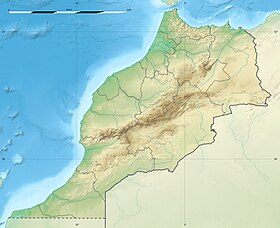
Morocco spans from the Mediterranean Sea and Atlantic Ocean on the north and the west respectively, into large mountainous areas in the interior, to the Sahara desert in the far south. Morocco is a Northern African country, located in the extreme northwest of Africa on the edge of continental Europe. The Strait of Gibraltar separates Spain from Morocco with a 13 kilometres (8.1 mi) span of water. Morocco borders the North Atlantic Ocean to the west, and the western Mediterranean Sea to the north.

Algeria comprises 2,381,741 square kilometers of land, more than four-fifths of which is desert, in northern Africa, between Morocco and Tunisia. It is the largest country in Africa. Its Arabic name, Al Jazair, derives from the name of the capital Algiers, after the small islands formerly found in its harbor. It has a long Mediterranean coastline. The northern portion, an area of mountains, valleys, and plateaus between the Mediterranean Sea and the Sahara Desert, forms an integral part of the section of North Africa known as the Maghreb. This area includes Morocco, Tunisia, and Libya.

The Atlas Mountains are a mountain range in the Maghreb. It separates the Mediterranean and Atlantic coastlines from the Sahara Desert. It stretches around 2,500 km (1,600 mi) through Morocco, Algeria and Tunisia. The range's highest peak is Toubkal, which is in central Morocco, with an elevation of 4,167 metres (13,671 ft). The Atlas mountains are primarily inhabited by Berber populations. The terms for 'mountain' are adrar and adras in some Berber languages. These terms are believed to be cognates of the toponym Atlas. The mountains are also home to a number of animals and plants which are mostly found within Africa but some of which can be found in Europe. Many of these species are endangered and a few are already extinct.

High Atlas, also called the Grand Atlas, is a mountain range in central Morocco, North Africa, the highest part of the Atlas Mountains.
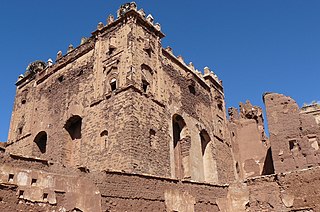
Telouet Kasbah is a Kasbah along the former route of the caravans from the Sahara over the Atlas Mountains to Marrakech. The kasbah was the seat of the El Glaoui family's power, thus sometimes also called the Palace of Glaoui. Its construction started in 1860 and it was further expanded in later years. The palace can still be visited but it is steadily becoming more damaged and is slowly collapsing. In 2010, work was underway to restore the property.

The Anti-Atlas, Lesser Atlas or Little Atlas is a mountain range in Morocco, a part of the Atlas Mountains in the northwest of Africa. The Anti-Atlas extends from the Atlantic Ocean in the southwest toward the northeast, to the heights of Ouarzazate and further east to the city of Tafilalt, altogether a distance of approximately 500 km. The range borders on the Sahara to the south.

The Middle Atlas is a mountain range in Morocco. It is part of the Atlas mountain range, a mountainous region with more than 100,000 km2, 15 percent of its landmass, rising above 2,000 metres. The Middle Atlas is the northernmost and second highest of three main Atlas Mountains chains of Morocco. To south, separated by the Moulouya and Um Er-Rbiâ rivers, lies the High Atlas. The Middle Atlas form the westernmost end of a large plateaued basin extending eastward into Algeria, also bounded by the Tell Atlas to the north and the Saharan Atlas to the south, both lying largely in Algeria. North of the Middle Atlas and separated by the Sebou River, lie the Rif mountains which are an extension of the Baetic System, which includes the Sierra Nevada in the south of Spain. The basin of the Sebou is not only the primary transportation route between Atlantic Morocco and Mediterranean Morocco but is an area, watered by the Middle Atlas range, that constitutes the principal agricultural region of the country.

The wildlife of Morocco is composed of its flora and fauna. The country has a wide range of terrains and climate types and a correspondingly large diversity of plants and animals. The coastal areas have a Mediterranean climate and vegetation while inland the Atlas Mountains are forested. Further south, the borders of the Sahara Desert are increasingly arid. Large mammals are not particularly abundant in Morocco, but rodents, bats and other small mammals are more plentiful. Four hundred and ninety species of birds have been recorded here.

Tata is a province in central Morocco with a population of 18.611 according to the country's 2014 census. It is the largest city in Tata Province.

The Permanent Maghreb of World Wide Fund for Nature is a freshwater ecoregion of North Africa.

Berkane Province is located in northeastern Morocco in the area of Béni-Snassen. It is bounded by the Mediterranean to its north, the Kiss Oued and Oujda Prefecture in the east, Nador Province to the west, and Taourirt Province in the south. The Berkane Province includes under its jurisdiction the towns of Saïdia and Ahfir. The population of the city is 80,012 as of the 2004 census. The population originates primarily from Yat Iznasen, a major tribe which consists of Berber clans. The tribe's descendants are spread widely over the rest of eastern Morocco, usually in cities like Ahfir, Saïdia and Oujda. Due to recent immigration originating from all over Morocco, the eastern dialect of Moroccan Arabic is spoken by most of the citizens, although Berber is still spoken by many of the adults.
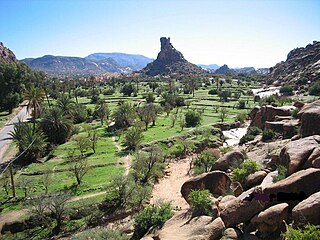
Tafraout is a town in Tiznit Province, Souss-Massa region, Morocco, in the central part of the Anti-Atlas mountains. It had a population of 4,931 at the 2004 census.

The Jbel Saghro or Djebel Sahrho is a mountain range in southern Morocco. It is located south of the High Atlas and east of the Anti-Atlas in the northwest of Africa, northeast of Taliouine and southwest of Ouarzazate.
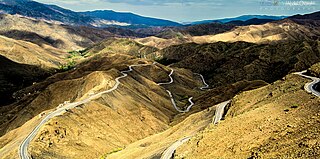
Tizi n'Tichka is a mountain pass in Morocco, linking the south-east of Marrakesh to the city of Ouarzazat through the High Atlas mountains. It lies above the great Marrakesh plains, and is a gateway to the Sahara Desert.
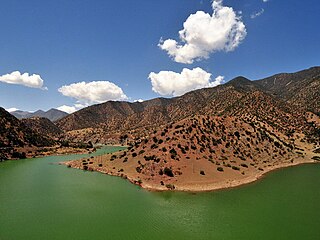
The Sous River or Souss River is a river in mid-southern Morocco located in the Sous region. It originates in the High Atlas and flows west passing Aoulouz, Taroudannt, Oulad Teima, Inezgane and Aït Melloul. It forms a basin which is protected from the desertic climate of the Sahara by the Anti-Atlas mountains and is one of Morocco's most fertile regions.

Maideria falipoui is a long-snouted brachythoracid arthrodire placoderm from the Lower Middle Givetian epoch of Middle Devonian South Morocco, in what is now the Anti-Atlas Mountains. Although M. falipoui superficially resembles Buchanosteus, albeit with an elongated snout or rostrum, M. falipoui is considered to be a basal member of the group Coccosteina, thus, it has not yet been given any familial ranking.

Mount Bou Iblan or Jbel Bou Iblane is a mountain of Taza the Fès-Meknès region of Morocco. Its altitude is 3,081 metres (10,108 ft)

Mount Bou Nasser or Jbel Bou Naceur is a mountain in Sefrou Province, Fès-Meknès, Morocco. Its altitude is 3,340 meters.

Tassemit or Jbel Tassemit, is a mountain of the Béni Mellal-Khénifra region of Morocco. Its altitude is 2,247m.
The geology of Morocco formed beginning up to two billion years ago, in the Paleoproterozoic and potentially even earlier. It was affected by the Pan-African orogeny, although the later Hercynian orogeny produced fewer changes and left the Maseta Domain, a large area of remnant Paleozoic massifs. During the Paleozoic, extensive sedimentary deposits preserved marine fossils. Throughout the Mesozoic, the rifting apart of Pangaea to form the Atlantic Ocean created basins and fault blocks, which were blanketed in terrestrial and marine sediments—particularly as a major marine transgression flooded much of the region. In the Cenozoic, a microcontinent covered in sedimentary rocks from the Triassic and Cretaceous collided with northern Morocco, forming the Rif region. Morocco has extensive phosphate and salt reserves, as well as resources such as lead, zinc, copper and silver.

